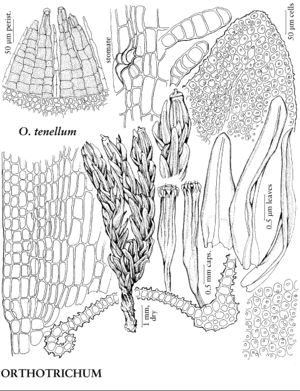Orthotrichum tenellum
Bryol. Univ. 1: 786. 1827.
Plants 0.3–1 cm. Stem-leaves stiff, erect-appressed when dry, ligulate to lanceolate-oblong, polymorphic, 1.3–2.6 mm; margins revolute to below apex or sometimes broadly reflexed distally, entire, sometimes serrulate in apex; apex obtuse to broadly acute, apiculate, incurved when dry; basal laminal cells broadly rectangular, walls thin, not nodose; distal cells 8–13 µm, 1-stratose, papillae 2 or 3 per cell, conic, low. Specialized asexual reproduction by gemmae on abaxial surface of leaves. Sexual condition cladautoicous or rarely gonioautoicous. Vaginula with hairs absent. Seta to 2 mm. Capsule 2/3 emergent to short-exserted, cylindric to cylindric-elliptic when mature, 1.3–2 mm, strongly 8-ribbed entire length, not constricted below mouth; stomata immersed, in proximal 1/3 of capsule, ± covered by subsidiary-cells, cells projecting, inner walls thickened; peristome double; prostome absent; exostome teeth 8, rarely splitting to 16, erect when mature, reflexed when old, papillose; endostome segments 8, rarely 16, well developed, of 2 rows of cells, finely papillose. Calyptra conic-oblong, smooth, naked or sparsely hairy, hairs sometimes papillose by projecting walls. Spores 11–18 µm.
Habitat: Trunks of deciduous trees in dry, open areas, rock
Elevation: low to high elevations (100-2000 m)
Distribution

B.C., Calif., Nev., Wash., Europe, n Africa, Atlantic Islands (Azores), Atlantic Islands (Canary Islands)
Discussion
Orthotrichum tenellum is the only western species with deeply immersed stomata, blunt leaves, and oblong-cylindric capsules; its small size distinguishes it from other Californian species found on trees. The leaves are spreading to wide-spreading in the distal portions of the branches.
Selected References
None.
Lower Taxa
"entire" is not a number.
